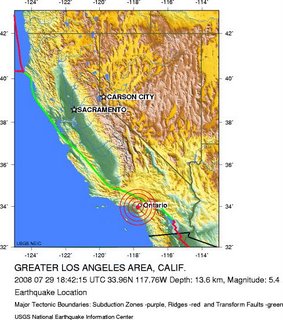A Wake Up Call

Tuesday’s earthquake in California was yet another reminder for Americans that mother- nature can strike an instant leaving little time for citizens who aren’t prepared to get prepared. Fortunately, there were only a handful of injuries and California Governor Arnold Schwarzenegger said it best “this earthquake reminds us to be prepared.”
Since early spring, Americans have been faced with an onslaught of severe weather from tornadoes, wildfires, flooding, a hurricane and now an earthquake all of which have put Americans on the front lines to face mother-nature. But despite the news coverage of these disasters Americans still seem to remain complacent when it comes to personal preparedness. Many believe that it won’t happen to them or if it does there isn’t anything they can do to protect themselves or their homes. This is simply untrue.
By having an emergency supply kit, an emergency plan, and being informed about the different types of emergencies that can happen and the appropriate responses, you will be able to make better choices when faced with an emergency in which you have only seconds to respond. Also, you are the first line of defense to any emergency or disaster and by taking steps to prepare you will not only be able to sustain yourself and your family for up to 72 hours or 3 days; but you will be freeing up valuable resources and allowing first responders to get to those who can’t take care of themselves first. Therefore, personal preparedness also becomes a civic responsibility.
But what does “being prepared” mean? The Department of Homeland Security’s Ready Campaign encourages everyone to have an emergency supply kit with basic essentials like food and water and unique family needs such as medication; to make an emergency plan that allows you and your family to establish meeting places, key contact information as well as plan ahead for an evacuation--you can find an emergency plan at www.ready.gov; and to be informed about the different types of emergencies that can happen in your area and learn the appropriate responses to them.
For example, earthquakes are sometimes believed to be a West Coast phenomenon, but there are actually 45 states and territories throughout the United States that are at moderate to high risk for earthquakes including the New Madrid fault line in the central U.S.
The federal government has taken many steps to improve our coordination with state and local authorities in times of emergencies and disasters. But it is also up to our citizens to take responsibility and make sure they and their families are prepared to deal with everything from power outages to large scale events such as Hurricane Dolly.
So let yesterday’s earthquake serve as a wake up call to you – visit www.ready.gov and make sure you are protecting yourself and your family for the unexpected.
David Paulison
FEMA Administrator
Labels: earthquakes, FEMA, natural disasters, preparedness






